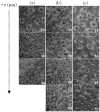Multiphoton redox ratio imaging for metabolic monitoring in vivo
- PMID: 20072916
- PMCID: PMC2874879
- DOI: 10.1007/978-1-60761-411-1_11
Multiphoton redox ratio imaging for metabolic monitoring in vivo
Abstract
Metabolic monitoring at the cellular level in live tissues is important for understanding cell function, disease processes, and potential therapies. Multiphoton imaging of the relative amounts of NADH and FAD (the primary electron donor and acceptor, respectively, in the electron transport chain) provides a noninvasive method for monitoring cellular metabolic activity with high resolution in three dimensions in vivo. NADH and FAD are endogenous tissue fluorophores, and thus this method does not require exogenous stains or tissue excision. We describe the principles and protocols of multiphoton redox ratio imaging in vivo.
Figures

References
-
- Chance B, Schoener B, Oshino R, Itshak F, Nakase Y. Oxidation-reduction ratio studies of mitochondria in freeze-trapped samples. NADH and flavoprotein fluorescence signals. J Biol Chem. 1979;254:4764–71. - PubMed
-
- Drezek R, Brookner C, Pavlova I, Boiko I, Malpica A, Lotan R, Follen M, Richards-Kortum R. Autofluorescence microscopy of fresh cervical-tissue sections reveals alterations in tissue biochemistry with dysplasia. Photochem Photobiol. 2001;73:636–41. - PubMed
-
- Gulledge CJ, Dewhirst MW. Tumor oxygenation: a matter of supply and demand. Anticancer Res. 1996;16:741–9. - PubMed
-
- Ramanujam N, Kortum RR, Thomsen S, Jansen AM, Follen M, Chance B. Low temperature fluorescence imaging of freeze-trapped human cervical tissues. Opt Express. 2001;8:335–343. - PubMed
Publication types
MeSH terms
Substances
Grants and funding
LinkOut - more resources
Full Text Sources
Other Literature Sources

